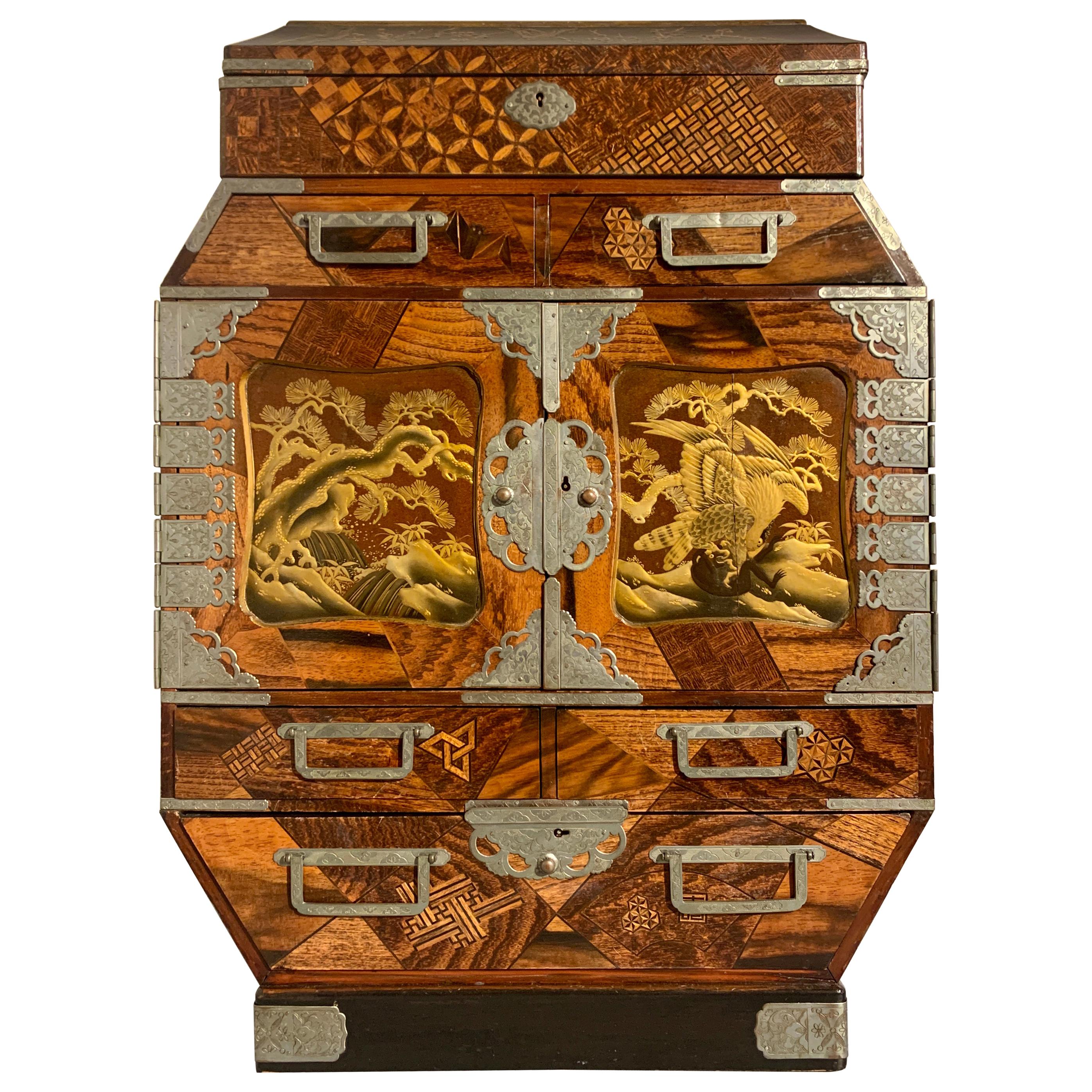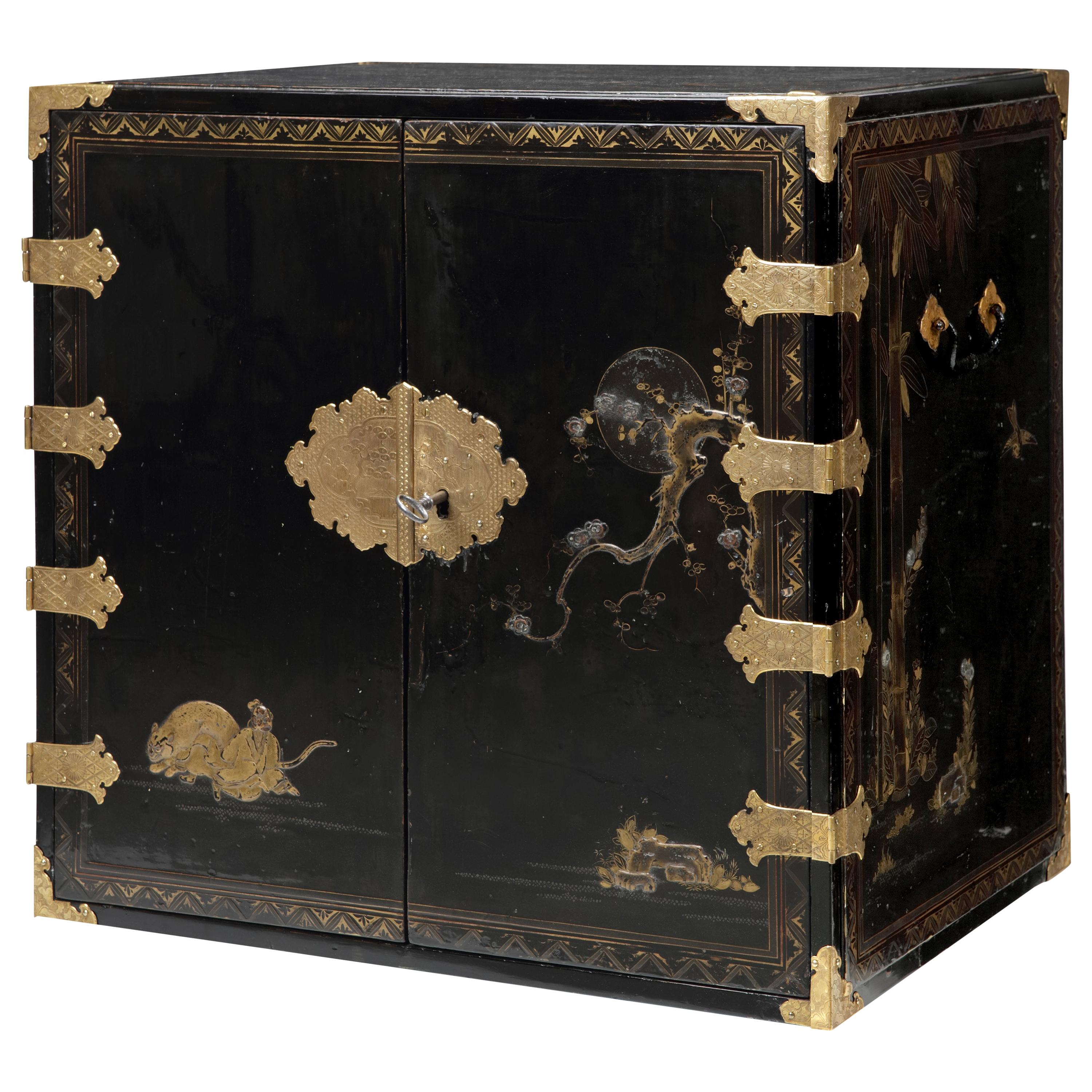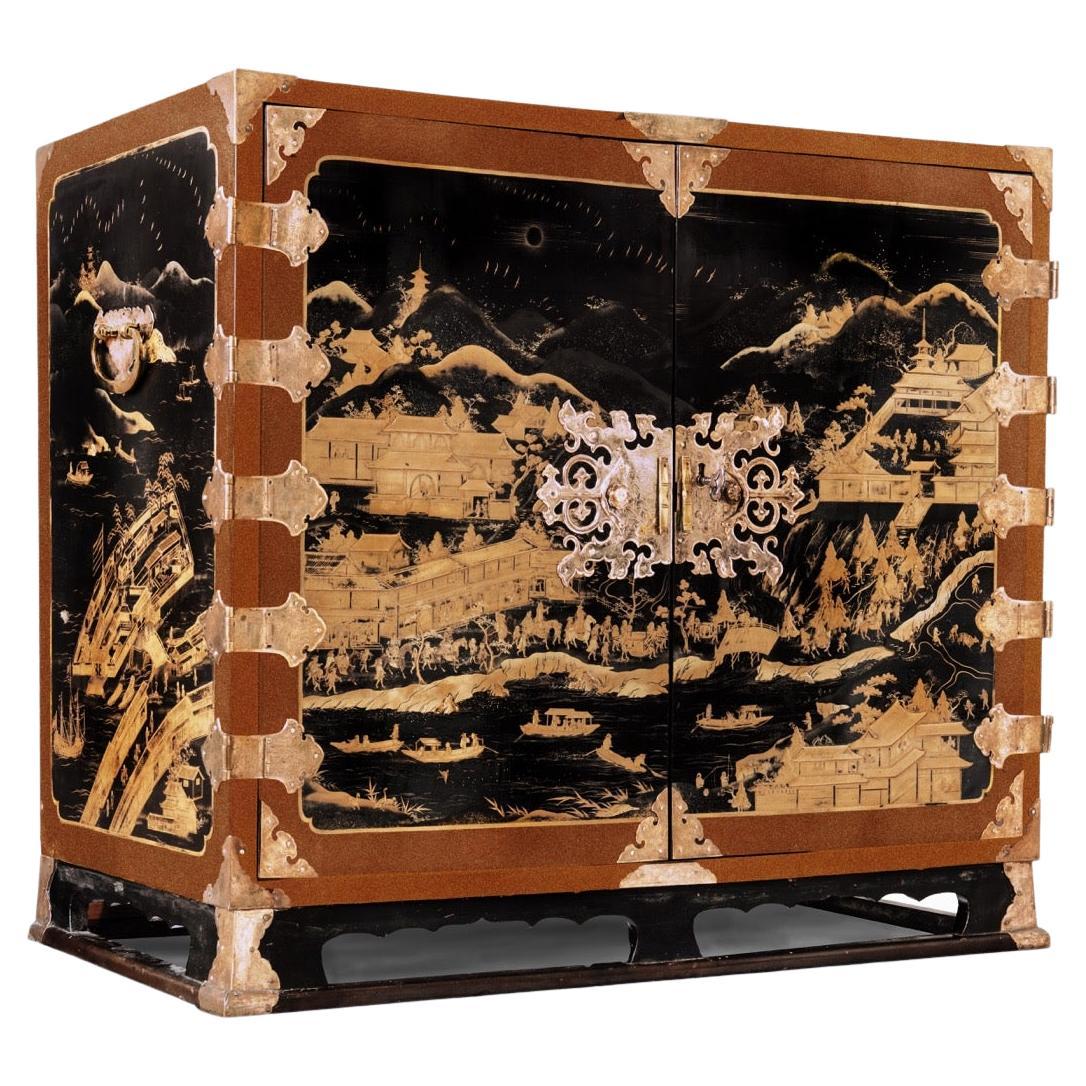Items Similar to Antique 20th Century Japanese Mother-of-Pearl Bento Box
Want more images or videos?
Request additional images or videos from the seller
1 of 12
Antique 20th Century Japanese Mother-of-Pearl Bento Box
About the Item
Beautiful and antique Japanese Mother-of-Pearl Bento Box with full array of components included. Unique iridescent lacquer finish throughout, with black & gold hand painted details at trim. The Bento Box includes the following:
(1) Small Shallow Tray: 7 - 1/2"W x 6 - 3/4"D x 3/4"H
(1) Stackable (4) Box Set with (1) Lid: 7 - 1/2"W x 6 - 3/4"D x 9"H
(1) Small Tray: 3 - 1/2"W x 6 - 1/2"D x 1 - 3/4"H
(1) Bottle Tray: 6 - 3/4"W x 3 - 1/2"D x 1 - 3/4"H
(2) Metal Bottles: 3" Diameter x 8 - 1/2" Height
Full set is raised on carved feet with decorative stretchers supporting the frame vertically. Solid brass carrying pull at top.
- Dimensions:Height: 12 in (30.48 cm)Width: 12 in (30.48 cm)Depth: 7 in (17.78 cm)
- Style:Other (In the Style Of)
- Materials and Techniques:Mother-of-Pearl,Lacquered
- Place of Origin:
- Period:
- Date of Manufacture:20th Century
- Condition:Wear consistent with age and use. The box itself along with components are all in good to excellent condition given the piece's age. There is a minor chip to the mother-of-pearl lacquer at the top surface, and slight denting to the metal bottles, but otherwise usable and stable.
- Seller Location:LOS ANGELES, CA
- Reference Number:1stDibs: LU2408327053162
About the Seller
4.0
Vetted Seller
These experienced sellers undergo a comprehensive evaluation by our team of in-house experts.
Established in 2009
1stDibs seller since 2016
41 sales on 1stDibs
Typical response time: 2 hours
- ShippingRetrieving quote...Ships From: LOS ANGELES, CA
- Return PolicyThis item cannot be returned.
More From This SellerView All
- Antique Meiji Period Japanese Wood PlanterLocated in LOS ANGELES, CAMeiji Period Japanese Planter in carved wood, featuring mother of pearl butterfly and floral insets, and finished copper inserts. Incredible craftsmanship and detail. Wood species un...Category
Antique 1870s Japanese Meiji Planters and Jardinieres
MaterialsWood
- Antique Meiji Period Japanese Wood PlanterLocated in LOS ANGELES, CAMeiji Period Japanese Planter in carved wood, featuring mother of pearl butterfly and floral insets, and finished copper inserts. Incredible craftsmanship and detail. Wood species un...Category
Antique 1870s Japanese Meiji Planters and Jardinieres
MaterialsWood
- Pair of Antique Neoclassical Armchairs, Early 19th CenturyLocated in LOS ANGELES, CAPair of antique neoclassical armchairs with flame mahogany frames, Velvet Upholstered seat, and Gilt-brass Hardware. These beautiful armc...Category
Antique Early 19th Century Baltic Neoclassical Armchairs
MaterialsBrass
- Antique Qajar Iran Lidded BoxLocated in LOS ANGELES, CAAntique solid brass lidded box from Qajar Iran, c. 20th century. Absolutely stunning piece with beautifully intricate engraving detail throughout. A diamond engraved pattern runs thr...Category
20th Century Persian Decorative Boxes
MaterialsBrass
- Antique Japanese Meiji Period Floor Lamp / LanternLocated in LOS ANGELES, CAIncredible antique Japanese floor lamp fabricated by hand with primitive, humble wood and painted finish. The lamp features an open top with an integrated carrying handle and a door ...Category
Antique 1880s Japanese Floor Lamps
MaterialsWood, Paper
- Pair of Antique Italian Neoclassical Style ArmchairsLocated in LOS ANGELES, CAPair of antique 17th century neoclassical style armchairs with original walnut finish (restored condition). Inside back, seat and arms uphol...Category
Antique Late 18th Century Italian Neoclassical Armchairs
MaterialsFabric, Walnut
You May Also Like
- Early 20th Century, Showa, a Pair of Japanese Lacquered TraysLocated in Sampantawong, THA pair of Japanese serving lacquered trays. Age: Japan, Showa Period, Early 20th Century Size: height 20.5 cm / width 38 cm / length 69 cm. Condition: Nice condition overall. ...Category
Early 20th Century Japanese Furniture
MaterialsWood
- Large Japanese Marquetry Table Cabinet, Meiji Period, Late 19th Century, JapanLocated in Austin, TXA fine and unusually large Japanese table cabinet or jewelry chest with yosegi marquetry work and lacquer paneled doors, Meiji period, late 19th century, Japan. The oversized tab...Category
Antique 1890s Japanese Meiji Furniture
MaterialsBrass
- Japanese Lacquer Display Cabinet on Stand, Meiji Period, 19th Century, JapanLocated in Austin, TXA spectacular Japanese lacquer and porcelain inlaid display cabinet on stand, kazaridana, Meiji Period, late 19th century, Japan. The sumptuous kazaridana of traditional display cabinet form, with several shelves and enclosed spaces for display and storage. The cabinet decorated all over in beautiful maki-e lacquer against a dense nashiji ground and inset with blue and white Arita porcelain plaques. The front of the cabinet of asymmetric design, with two open display shelves at staggered heights, and several doors enclosing storage areas of various shapes and sizes, including one hinged corner door, two pairs of sliding doors, and one pair of hinged doors opening to reveal a rounded inset corner shelf. A pair of drawers below complete the cabinet. All supported on a separate tall fitted stand. The corner door decorated with a bold scene of a samurai warrior fighting a demon. This most likely depicts the warrior Watanabe no Tsuna battling the demon Ibaraki-doji at Rashomon gate, in which Watanabe no Tsuna attempts to help a young girl return home, carrying her on his back, only for the girl to turn into a demon, which he then must fight. The top pair of sliding doors with a scene of a man playing the sho, a Japanese mouth organ, along the banks of a river with a waterfall in the background. The bottom pair of sliding doors with a waterfall scene on one side, while a scholar lounges with his attendants on the other. The pair of hinged doors finely decorated with a pair of fully armored samurai. The two drawers wonderfully decorated in the kodaiji style with a stream of rushing water and various plants and grasses. The cabinet is decorated in the round, with the top, sides, and base of the cabinet decorated with various scenes of flowers and birds, and inset with blue and white Arita porcelain plaques in the form of traditional fan. The fans painted...Category
Antique 1880s Japanese Meiji Lacquer
MaterialsPorcelain, Softwood, Lacquer
- Antique Japanese Export Lacquer Bamboo Stick StandLocated in Brea, CAAntique Japanese export lacquer and gilt bamboo stick stand, see more pictures, 46'' x 27.5'' x 10''.Category
Early 20th Century Japanese Meiji Lacquer
MaterialsBamboo
- Rare Charming 17th Century Japanese Lacquer Cabinet with Gilt-Bronze MountsLocated in Amsterdam, NLA fine Japanese pictoral style lacquer cabinet with gilt-metal mounts Kyoto, Edo period, 1670-1690 Decorated in Japanese relief lacquer work, black lacquer ground decorated...Category
Antique Late 17th Century Japanese Furniture
MaterialsBronze
- 17th Century Japanese Export Lacquer Cabinet with Depiction the Dutch TradepostLocated in Amsterdam, NLA highly important Japanese export lacquer cabinet with depiction of the Dutch East India Company tradepost Deshima and the annual Dutch delegation on its way to the Shogun in Edo Edo period, circa 1660-1680 H. 88 x W. 100.5 x D. 54 cm This cabinet includes a later European japanned stand, but also a modern powder-coated steel frame. The latter can be designed and added to your specific needs. The sides and front of the rectangular two-door cabinet are embellished in gold and silver hiramaki-e and takamaki-e on a black roiro lacquer ground with a continuous design. The two doors depict a long procession of numerous figures travelling on foot and horseback along buildings and a pagoda into a mountainous landscape. This is the annual court journey, Hofreis, of the Dutch from Nagasaki to the Shogun’s court in Edo. Three horseback riders are dressed as Dutch merchants and a fourth figure, probably het Opperhoofd, is seen inside a palanquin, norimon. Just about to cross the bridge, two men are carrying a cabinet like the present one. Many Japanese figures on either side of the procession are engaged in various activities; some play musical instruments on board of small boats, others are fishing; figures inside buildings are depicted playing go, and farmers are tending to their rice paddocks. The upper part of the right door shows a large mansion, probably the local daimyo’s castle, with men kneeling before a man in the central courtyard. The court journey fits in with the foreign policy of the shogunate which accorded a role to the VOC alongside China, Korea, and the Ryukyu Islands who also had to pay tribute. However, the VOC employees were traders, having low status in Japan’s social hierarchy, and they were received with less deference than were the state embassies from Korea and the Ryukyu Islands. Nevertheless, the contacts with the Dutch were a welcome source of information to the Shogun about Europe and European science and technology. The left side of the cabinet depicts, in mirror image, a rare view of the artificial fan-shaped Deshima Island, the trading post for the Dutch in Japan. The island, where the Dutch flag flies, is surrounded by small Japanese boats and an anchored three-masted fluyt (cargo ship), flying Dutch flags, with on the stern the VOC monogram. On the bottom right a busy street of Nagasaki is shown, bordered by shops and leading up to the stone bridge. On the island the trees are beautifully painted, two cows can be seen, and the flagpole, all in very fine detail. Dutchmen and enslaved Malay are visible outside the buildings and two Japanese figures, probably guards, sit in a small hut in the centre. A maximum of fifteen to twenty Dutchmen lived on the island at any time and soldiers or women were not allowed. Restrictions on Deshima were tight, and the merchants were only allowed to leave the island by special permission. The Opperhoofd had to be replaced every year, and each new Opperhoofd had to make a court journey to pay tribute, present gifts, and to obtain permission to Margaret Barclay eep on trading. In the distance, many birds fly above the hills and a four-story pagoda can be seen. The right side of the cabinet is painted with other horse riders and their retinue journeying through mountains. The pair of doors to the front open to reveal ten rectangular drawers. The drawers are decorated with scenes of birds in flight and landscapes with trees and plants. The reverse of the left door with two thatched buildings, one with a ladder, underneath a camelia tree with large blooms; the right door with a three-story pagoda nestled among trees and both doors with a flying phoenix, ho-oo bird. The cabinet, with elaborately engraved gilt copper mounts, hinges, lock plates and brass handles, is raised on an 18th-century English japanned wood stand. A pair of large cabinets...Category
Antique 17th Century Japanese Edo Lacquer
MaterialsCopper, Gold
Recently Viewed
View AllMore Ways To Browse
Pearl And Mother Of Pearl
Pearl Furniture
Mother Of Pearl Furniture
Furniture With Mother Of Pearl
Japan Finish
Mother Of Pearl Art
Asian Gold Antiques
Mother Of Pearl Top
Japanned Finish
Japanese Pearls
Pearls Japan
Japan Solid
Carved Mother Pearl
Antique Carved Japanese Furniture
Brass Mother Of Pearls
Antique Mother Of Pearl Furniture
Black And Gold Antique Boxes
Black Mother Of Pearl Furniture





